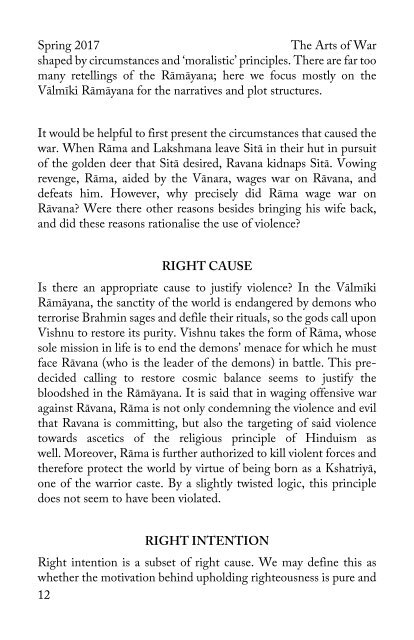The Creative Process: The Arts of War (Spring 2017)
The Creative Process is The Mumbai Art Collective's flagship magazine.
The Creative Process is The Mumbai Art Collective's flagship magazine.
Create successful ePaper yourself
Turn your PDF publications into a flip-book with our unique Google optimized e-Paper software.
<strong>Spring</strong> <strong>2017</strong><br />
<strong>The</strong> <strong>Arts</strong> <strong>of</strong> <strong>War</strong><br />
shaped by circumstances and ‘moralistic’ principles. <strong>The</strong>re are far too<br />
many retellings <strong>of</strong> the Rāmāyana; here we focus mostly on the<br />
Vālmīki Rāmāyana for the narratives and plot structures.<br />
It would be helpful to first present the circumstances that caused the<br />
war. When Rāma and Lakshmana leave Sitā in their hut in pursuit<br />
<strong>of</strong> the golden deer that Sitā desired, Ravana kidnaps Sitā. Vowing<br />
revenge, Rāma, aided by the Vānara, wages war on Rāvana, and<br />
defeats him. However, why precisely did Rāma wage war on<br />
Rāvana? Were there other reasons besides bringing his wife back,<br />
and did these reasons rationalise the use <strong>of</strong> violence?<br />
RIGHT CAUSE<br />
Is there an appropriate cause to justify violence? In the Vālmīki<br />
Rāmāyana, the sanctity <strong>of</strong> the world is endangered by demons who<br />
terrorise Brahmin sages and defile their rituals, so the gods call upon<br />
Vishnu to restore its purity. Vishnu takes the form <strong>of</strong> Rāma, whose<br />
sole mission in life is to end the demons’ menace for which he must<br />
face Rāvana (who is the leader <strong>of</strong> the demons) in battle. This predecided<br />
calling to restore cosmic balance seems to justify the<br />
bloodshed in the Rāmāyana. It is said that in waging <strong>of</strong>fensive war<br />
against Rāvana, Rāma is not only condemning the violence and evil<br />
that Ravana is committing, but also the targeting <strong>of</strong> said violence<br />
towards ascetics <strong>of</strong> the religious principle <strong>of</strong> Hinduism as<br />
well. Moreover, Rāma is further authorized to kill violent forces and<br />
therefore protect the world by virtue <strong>of</strong> being born as a Kshatriyā,<br />
one <strong>of</strong> the warrior caste. By a slightly twisted logic, this principle<br />
does not seem to have been violated.<br />
RIGHT INTENTION<br />
Right intention is a subset <strong>of</strong> right cause. We may define this as<br />
whether the motivation behind upholding righteousness is pure and<br />
12



